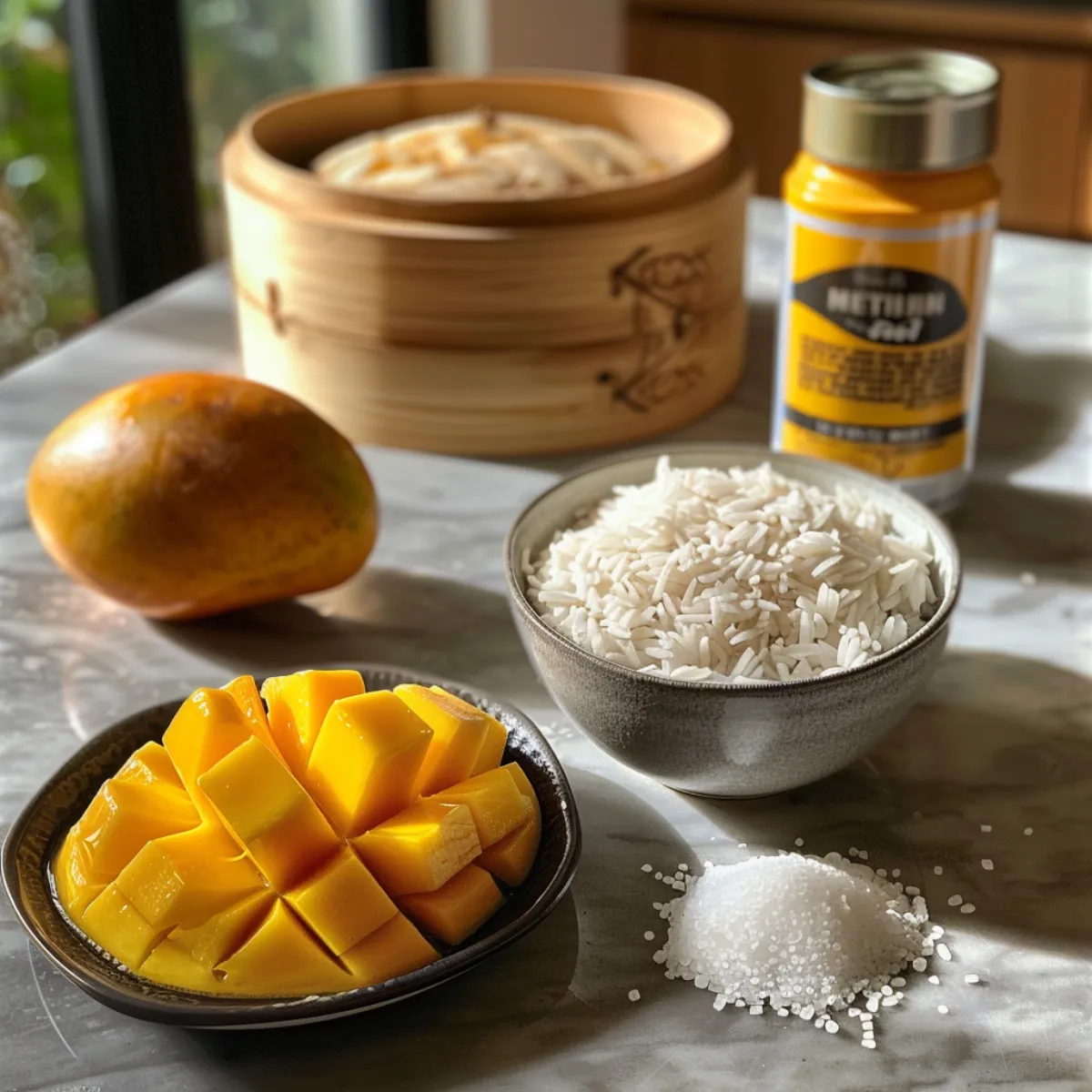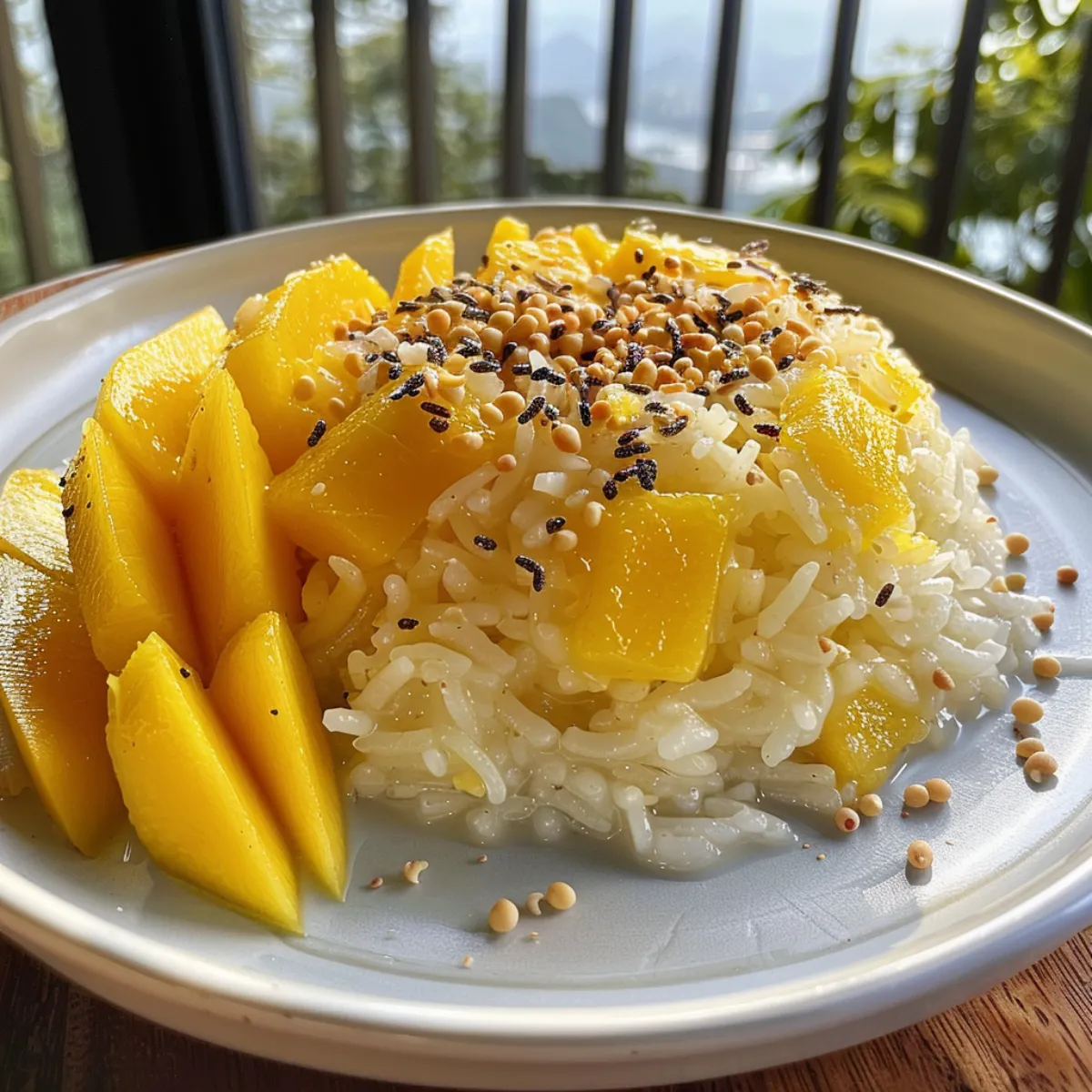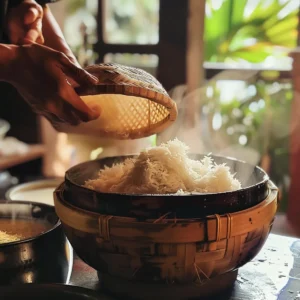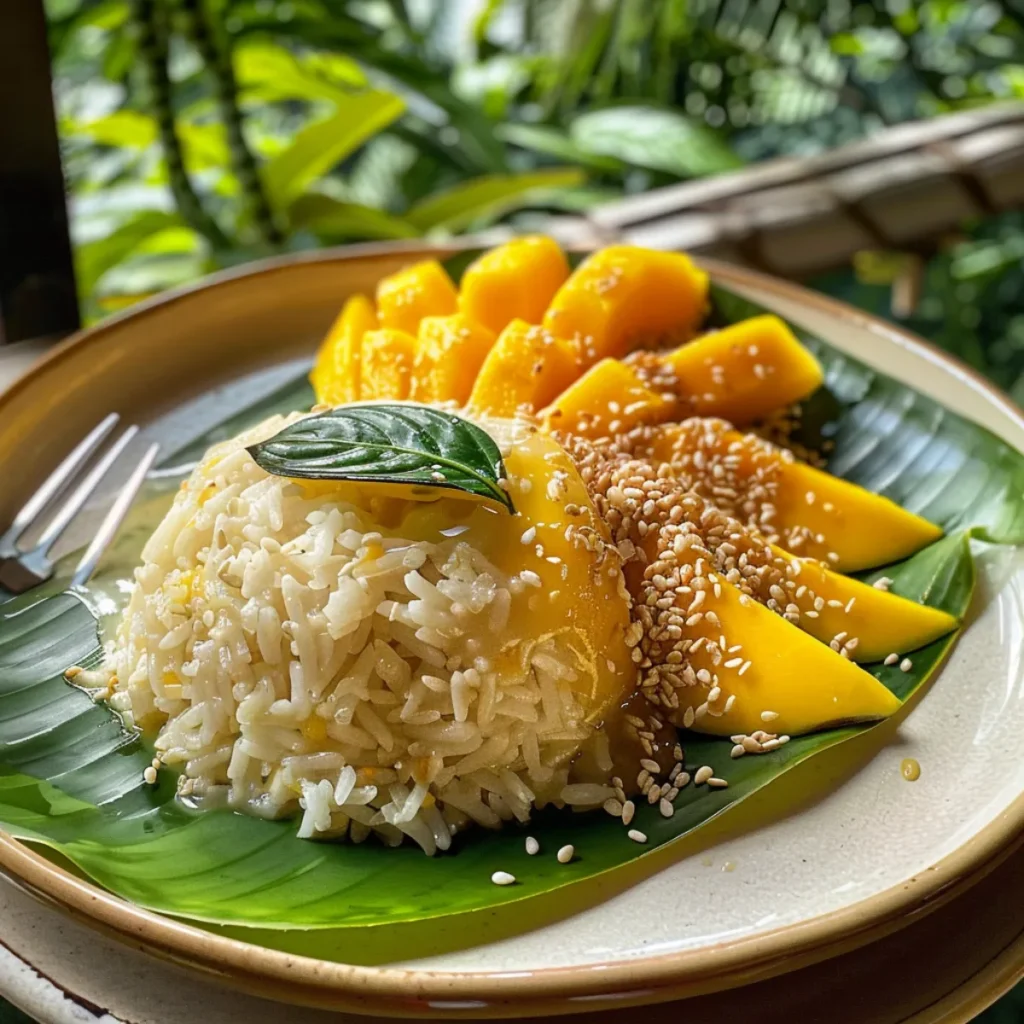Introduction
Mango sticky rice is more than just a dessert—it’s a celebration of tropical sweetness and Thai culture. The first time I tried it was on a sticky summer night in Chiang Mai, where street vendors handed out warm parcels of glutinous rice topped with juicy mango and soaked in rich coconut cream. That first bite? Unforgettable. It was soft, creamy, fragrant, and unlike anything I’d ever tasted.
As someone who’s traveled to discover how cultures express themselves through food, mango sticky rice quickly earned a permanent place in my heart—and my kitchen. I’ve recreated it in tiny apartments and open-air markets, tweaking techniques, learning from Thai locals, and savoring each variation. This guide shares all those lessons with you.
We’ll explore everything from how mango sticky rice came to be so beloved in Thailand, to the kind of rice you should use, and even how to make your own at home. Whether you’re a food lover chasing exotic desserts or just curious about what makes mango sticky rice so special, you’re in the right place.
Let’s dive into the delicious world of this iconic Thai dish.
Table of Contents
Exploring the Origins of Mango Sticky Rice
The cultural roots of mango sticky rice in Thai tradition
Mango sticky rice isn’t just a dish—it’s a seasonal celebration deeply woven into the rhythm of Thai life. Known in Thai as Khao Niew Mamuang, this dessert is typically enjoyed during the peak mango season, from April to June, when the fruit is at its juiciest and most fragrant. This timing also aligns with the end of the rice harvest, when glutinous rice is fresh and plentiful.
In Thai households, mango sticky rice is more than food—it’s an offering, a tradition, and often a symbol of good luck. It plays a significant role during Songkran, the Thai New Year, where families come together and prepare it as a gesture of gratitude for abundance. Sweetness in Thai food represents love, harmony, and balance, and this dessert perfectly expresses that sentiment.
As I learned during my stay in northern Thailand, making mango sticky rice isn’t rushed. It’s slow, intentional, and shared—much like a story passed down through generations.
How this dessert became globally popular
So how did mango sticky rice make its way from quiet village markets in Thailand to international fame? The journey began with Thai restaurants opening across Europe and North America in the 1990s and early 2000s. Diners were intrigued by the contrast of sweet mango and salty-sweet coconut rice—a flavor combo that was unfamiliar but irresistible.
Then came the digital wave. As food bloggers, YouTubers, and Instagrammers highlighted colorful plates of mango sticky rice, its popularity exploded. People were captivated by its tropical charm and exotic appeal.
Interestingly, even modern chefs have embraced mango sticky rice in high-end culinary spaces. You’ll now see deconstructed versions, rolled sushi-style spins, and parfait-inspired jars in trendy cafes. Yet, no matter the twist, its soul remains rooted in tradition.
Mango sticky rice’s rise isn’t just about taste—it’s about how a dish can connect people across continents with a single spoonful.
Ingredients That Make Mango Sticky Rice Special
Why glutinous rice is the star of the dish
When it comes to mango sticky rice, not just any rice will do. The key ingredient is glutinous rice, also known as sticky rice or sweet rice. Don’t let the name fool you—it doesn’t contain gluten. Instead, it’s called “glutinous” because of its sticky, chewy texture once cooked, which makes it ideal for desserts like this one.

I remember my first attempt at using jasmine rice instead. Big mistake! The texture was too loose and the flavor just didn’t hold up. Glutinous rice, on the other hand, soaks up the coconut sauce like a sponge, holding everything together in one creamy, sweet bite.
You’ll want to soak the rice for at least 4 hours (or overnight) before steaming. This step is crucial—rushing it results in uneven cooking and a dry finish. Thai home cooks often steam it in a bamboo basket, which allows for better airflow and fluffier results. The aroma? Lightly nutty, warm, and utterly inviting.
Choosing the perfect mango for balance and flavor
Not all mangoes are created equal—especially when it comes to mango sticky rice. The variety you choose can make or break the dish. In Thailand, they use Nam Dok Mai or Ok Rong mangoes, both known for their buttery texture and honey-like sweetness. Outside of Thailand, look for Ataulfo or Champagne mangoes. They’re silky, rich, and less fibrous than common varieties like Tommy Atkins.
I learned to always check the scent before buying. A ripe mango should smell sweet at the stem. And when you gently press the skin, it should yield slightly—too firm means it’s underripe, too soft and you’ve crossed into jam territory.
For the best result, slice the mango just before serving. This keeps it vibrant, fresh, and full of natural juice that complements the warm sticky rice and coconut sauce perfectly.
Preparing the Rice – Sticky but Perfectly Soft
The soaking and steaming method explained
The secret to making perfect mango sticky rice starts long before you add the mango or the sauce—it begins with how you handle the rice. Glutinous rice requires care. First, it needs to be rinsed multiple times until the water runs clear. This step removes excess starch, which can make the rice gummy instead of delightfully chewy.
Then comes the soaking phase. I usually soak my rice overnight, but if you’re short on time, four hours will do. This step allows the grains to swell, ensuring even cooking. Without it, you’ll likely end up with rice that’s crunchy in the center and mushy outside—not what you want in this dish.
For cooking, I strongly recommend steaming over boiling. Traditional Thai kitchens use a bamboo steamer over a pot of boiling water. The steam gently cooks the rice while preserving its structure. If you don’t have a bamboo steamer, a metal mesh steamer basket or cheesecloth over a colander can work just as well.
When it’s done, the rice should be soft, sticky, and slightly translucent. It should clump when pressed but not turn into a paste.
Secrets to achieving the ideal sticky texture
Perfect sticky rice isn’t just about cooking—it’s about what happens right after. While the rice is still hot, it’s mixed with warm sweetened coconut milk (more on that in Part 4). This is where the magic happens. The rice soaks in the coconut cream, transforming into something luxurious.
Here’s a trick I learned in Bangkok: don’t stir the coconut milk in all at once. Pour it gradually and fold it in gently. This helps each grain absorb the liquid without breaking or turning mushy.
Let the rice rest, covered, for about 20–30 minutes after mixing. This allows the flavors to deepen and the texture to set. By the time you plate it with fresh mango slices and drizzle more coconut sauce over the top, you’ll have that iconic Thai dessert that’s rich, fragrant, and beautifully balanced.
Coconut Sauce – The Silky Rich Companion
What goes into authentic coconut sauce
Now, let’s talk about the silky coconut sauce—because mango sticky rice just wouldn’t be the same without it. This sauce isn’t just a drizzle; it’s the soul of the dish. The richness of coconut milk balances the natural sweetness of the mango and the chewiness of the rice, creating a harmony that lingers on the tongue.
An authentic Thai coconut sauce includes only a few ingredients:
- Full-fat coconut milk
- Sugar (often palm sugar in traditional recipes)
- A pinch of salt
- Sometimes a bit of rice flour or cornstarch to thicken it
I remember watching a grandmother in Ayutthaya prepare this in a tiny clay pot. She didn’t measure—she tasted. Her version was slightly salty, which I later learned is traditional in many parts of Thailand. That salty edge? It’s intentional. It helps enhance the sweetness of the mango and the rice, creating depth.
You’ll want to heat the coconut milk gently—not boil it—to preserve its creamy texture. The aroma alone will transport you to a Thai kitchen.
Sweet vs. salty coconut cream – regional variations
One of the beautiful things about Thai food is its regional diversity, and mango sticky rice is no exception. In central Thailand, the coconut sauce tends to be sweeter. But go north or to some parts of Isaan, and you’ll find versions that lean more savory with an extra pinch of salt or even a hint of sesame.
Some regions also top the dish with mung beans or toasted sesame seeds for crunch, while others add a second drizzle of thickened coconut cream just before serving.
I personally love experimenting. Sometimes I make the base sauce sweet and add a final drizzle of salty coconut cream for contrast—it’s like hitting two notes of flavor in one bite.
Whether you prefer it sweet, salty, or somewhere in between, this coconut sauce is what binds the dish together. It wraps around the rice like a warm blanket, enhancing the fruit without overpowering it.
Serving Mango Sticky Rice – Hot, Cold, or Room Temperature?
Traditional serving methods in Thai households
One of the most common questions I get is: “Is mango sticky rice supposed to be hot or cold?” The answer? It depends on who you ask—and where in Thailand you are.
Traditionally, mango sticky rice is served warm or at room temperature. The sticky rice is often freshly steamed and then mixed with warm coconut sauce, so it retains that soft, velvety texture. The mango, on the other hand, is typically served at room temperature or slightly chilled. This contrast—the warm rice, the cool fruit—is what creates such a satisfying mouthfeel.
In most Thai homes I visited, the dessert is plated just before eating. A scoop of sticky rice is molded into a neat mound, mango slices are fanned beside it, and the entire dish is bathed in coconut sauce, sometimes finished with a drizzle of salty coconut cream or a few crunchy mung beans.
This balance of textures and temperatures is part of what makes mango sticky rice feel luxurious, yet humble.
Best practices for presentation and taste
If you’re serving mango sticky rice at home (and I hope you do!), a few small touches can elevate your presentation and flavor experience:
- Use a round mold or small bowl to shape the sticky rice—this makes the plate look elegant and intentional.
- Slice the mango vertically and fan the pieces out to show off that golden, juicy flesh.
- Warm your coconut sauce just before drizzling, and save a tablespoon to thicken slightly for that final glossy finish on top.
- Optional toppings like toasted mung beans, sesame seeds, or coconut flakes can add texture and visual interest.
And timing matters too. I always aim to serve the dish within 30 minutes of assembling it. That way, the rice stays soft, the mango remains fresh, and the coconut sauce doesn’t soak in too much and dry out the plate.
Mango sticky rice may seem simple, but every detail—from temperature to texture—plays a role in making it unforgettable.
Variations and Modern Twists on Mango Sticky Rice
Creative versions using different fruits and sauces
While the traditional mango sticky rice is nearly perfect on its own, that hasn’t stopped home cooks and chefs from experimenting. As someone who loves blending global flavors, I’ve tried dozens of spins on the classic—and some are just too good not to share.
One of the most popular variations swaps out mango for other tropical fruits. Think:
- Lychee sticky rice: sweet, floral, and juicy
- Pineapple sticky rice: more acidic and vibrant
- Jackfruit sticky rice: chewy and deeply fragrant
Then there’s the infused rice trend—where the rice itself is flavored or colored naturally. I’ve seen pandan-infused rice (a light green tint with grassy vanilla notes) or butterfly pea rice (a striking blue-purple that turns magenta when citrus is added).
Sauce-wise, some versions use condensed milk instead of coconut cream, while others introduce a drizzle of salted caramel or chocolate for fusion flair. I’ve even had a Thai-Mexican version served taco-style in a rice paper wrap—wild, but delicious.
Vegan, sugar-free, and fusion spins
The beauty of mango sticky rice is that it’s naturally gluten-free and easily made vegan. Just make sure your coconut milk and sugar (especially white sugar) are vegan-certified, as some are processed with bone char.
For those cutting down on sugar, coconut sugar or monk fruit sweetener work well without overpowering the flavor. I once made a version with agave syrup and found it surprisingly balanced.
Fusion versions are also on the rise. I’ve seen:
- Mango sticky rice sushi rolls wrapped in rice paper
- Sticky rice parfaits layered with fruit and coconut cream in jars
- Deconstructed plates with rice crisps, mango foam, and coconut gel—perfect for fine dining menus
Even something as simple as adding a dash of lime zest or a pinch of crushed pink peppercorns can breathe new life into this traditional dish.
Mango sticky rice may have humble roots, but it’s also incredibly adaptable. Whether you’re keeping it classic or going bold, there’s room to make it your own.
Nutritional Profile and Dietary Considerations
Health benefits and caloric breakdown
Let’s be real—mango sticky rice isn’t exactly diet food, but it’s not something to feel guilty about either. It’s a wholesome dessert made from real, minimally processed ingredients. The key is portion control and understanding what you’re eating.

Here’s a rough breakdown for a standard serving (about 1 cup sticky rice + ½ mango + coconut sauce):
| Component | Calories | Protein | Carbs | Fat |
|---|---|---|---|---|
| Glutinous Rice | ~170 | 3g | 37g | 0g |
| Mango | ~100 | 1g | 25g | 0g |
| Coconut Sauce | ~150 | 1g | 10g | 12g |
| Total (est.) | 420 | 5g | 72g | 12g |
The good news? Mango is packed with vitamin C, fiber, and antioxidants. Coconut milk provides healthy fats—especially lauric acid, which may support immune health. Sticky rice, while high in carbs, is also easy to digest.
But like any dessert, moderation is key. A small serving is satisfying, thanks to the richness of the coconut and the natural sweetness of the mango.
How to make it fit into different dietary lifestyles
The beauty of mango sticky rice is its flexibility. You can adapt it to suit various lifestyles without compromising the essence of the dish.
Vegan? You’re good to go—just double-check that your sugar is bone-char-free.
Dairy-free? Always—it uses coconut milk instead of cream or butter.
Gluten-free? Yep, sticky rice is naturally free of gluten.
Low-sugar? Try using coconut sugar or erythritol. You can also reduce the amount of sugar in the coconut sauce without losing too much flavor.
If you’re watching carbs, try a smaller portion or use black sticky rice, which has more fiber and a slightly nutty taste.
Personally, I love making this dish on weekends when I want something comforting but not too heavy. The mix of fruit, grain, and coconut makes it feel like a balanced indulgence.
FAQs about Mango Sticky Rice
What is so special about mango sticky rice?
Mango sticky rice is special because it’s more than the sum of its parts. The dish combines chewy glutinous rice, sweet ripe mango, and rich coconut cream to create a texture and flavor contrast that’s both comforting and exotic. What really makes it unique is the balance of sweet, salty, and creamy—a flavor trio that’s signature to Thai desserts.
But beyond taste, it’s also deeply cultural. In Thailand, mango sticky rice is a seasonal delight, often tied to celebrations like the Thai New Year (Songkran). It’s a food that carries emotional value, family tradition, and national pride—all served on one beautiful plate.
What kind of rice is used for mango sticky rice?
The dish uses glutinous rice, also known as sticky rice or sweet rice. It’s not the same as sushi rice or jasmine rice. Glutinous rice has a higher starch content that gives it its characteristic stickiness once steamed.
You can find glutinous rice in most Asian grocery stores, usually labeled clearly. Look for long-grain varieties if you want to stay authentic. Avoid using regular white rice—it won’t absorb the coconut sauce properly and the texture won’t hold up.
Is mango sticky rice supposed to be hot or cold?
Here’s a fun twist—it can be either, but traditionally, mango sticky rice is served warm or at room temperature. The rice is often freshly cooked and warm when mixed with coconut sauce, while the mango is cool or room-temp. This contrast in temperatures adds to the eating experience.
Serving it chilled is also common in Western adaptations, especially when made in advance or served in restaurants. If you’re making it at home, aim to serve the rice warm for the most authentic flavor and texture.
Do Thai people eat mango sticky rice?
Absolutely! In Thailand, mango sticky rice is a beloved dessert. Locals eat it during mango season (usually from March to June) and during cultural events. You’ll find it at street markets, in home kitchens, and at upscale restaurants.
It’s a dessert that crosses social classes and generations—from children to elders, everyone enjoys it. I even met a Bangkok tuk-tuk driver who insisted the best version is sold by a 70-year-old woman who steams her rice over charcoal near Chatuchak Market. It’s truly a food of the people.
Final Thoughts & How to Make Your Own
A simple recipe from my kitchen
After tasting mango sticky rice across Thailand and trying out dozens of versions at home, I’ve found a method that’s both simple and true to tradition. Here’s how I make it in my own kitchen—with a few tips I picked up from local cooks during my travels.
Ingredients:
- 1 cup glutinous rice (soaked overnight)
- 1 ½ cups coconut milk (full-fat)
- ⅓ cup sugar (palm sugar or white sugar)
- ½ tsp salt
- 2 ripe mangoes, peeled and sliced
- 1 tsp cornstarch (optional, for thickening sauce)
- Toasted sesame seeds or mung beans (optional topping)
Instructions:
- Steam the rice: After soaking, rinse well and steam for 20–30 minutes until soft and sticky.
- Make the sauce: In a saucepan, heat coconut milk, sugar, and salt on low. Stir until sugar dissolves. Set aside ¼ cup for topping.
- Mix rice with sauce: While rice is hot, combine it with the remaining coconut sauce. Let sit covered for 20–30 minutes.
- Prepare the topping: Optional—add cornstarch to the reserved sauce and heat until thickened.
- Assemble: Shape rice into a mound, arrange mango slices beside it, and drizzle with the thickened coconut sauce. Add toppings if desired.
Lessons learned from making mango sticky rice around the world
Mango sticky rice taught me that simplicity often hides great depth. The dish uses just a few ingredients, but the balance and timing are everything. Each time I’ve made it—whether in a hostel kitchen in Bali or at home in Colorado—it’s reminded me of the joy of learning through food.
Cooking this dish isn’t just about following steps. It’s about noticing how the coconut milk thickens, how the mango smells when it’s perfectly ripe, and how the rice holds just the right amount of stickiness. It’s about sharing something beautiful, honest, and culturally rich.
Conclusion
Mango sticky rice is more than just a dessert—it’s an invitation to slow down, savor the moment, and connect with a culture through flavor. Whether you’re making it for guests or simply treating yourself, this Thai classic never fails to bring a little sunshine to your plate.
Let’s stay connected on Facebook: Follow me here for cooking stories and weekly dessert ideas.
Love pinning recipes? Join me on Pinterest where I share my favorite homemade desserts and global food finds.

Mango Sticky Rice – The Irresistible Thai Dessert You Need to Try
Mango sticky rice is more than a dessert—it’s a celebration of tropical sweetness, creamy coconut, and Thai culture. A dish that’s both luxurious and humble, and unforgettable from the very first bite.
- Total Time: 35 minutes (excluding soak)
- Yield: 4 servings 1x
Ingredients
- 1 cup glutinous rice (sweet/sticky rice)
- 1 ½ cups full-fat coconut milk
- ½ cup sugar (palm sugar or white)
- ½ teaspoon salt
- 1 tablespoon rice flour or cornstarch (optional, for thickening)
- 2 ripe mangoes (Ataulfo or Nam Dok Mai preferred)
- Optional toppings: toasted sesame seeds, crispy mung beans, or coconut flakes
Instructions
- Rinse glutinous rice several times until water runs clear.
- Soak the rice for at least 4 hours or overnight.
- Steam the soaked rice in a bamboo or mesh steamer for 20–25 minutes until soft and translucent.
- While rice cooks, heat coconut milk gently with sugar and salt—do not boil.
- Optional: Stir in a bit of rice flour or cornstarch to thicken sauce slightly.
- When rice is done, transfer to a bowl and gradually fold in most of the coconut sauce. Let rest, covered, for 20–30 minutes.
- Peel and slice ripe mangoes just before serving.
- Plate sticky rice and mango, then drizzle remaining coconut sauce over the top.
- Sprinkle optional toppings like toasted mung beans or sesame seeds for extra texture.
- Serve warm or at room temperature for best texture and flavor.

Notes
Make sure to use glutinous rice, not jasmine or long-grain. Slice mango fresh to preserve its juiciness. Sweetness and salt in the coconut sauce should be balanced for authentic Thai flavor.
- Prep Time: 5 minutes (plus soaking time)
- Cook Time: 30 minutes
- Category: Dessert
- Method: Steamed
- Cuisine: Thai
- Diet: Vegan
Nutrition
- Serving Size: 1 plate
- Calories: 420
- Sugar: 35g
- Sodium: 150mg
- Fat: 12g
- Saturated Fat: 10g
- Unsaturated Fat: 2g
- Trans Fat: 0g
- Carbohydrates: 72g
- Fiber: 2g
- Protein: 5g
- Cholesterol: 0mg








2 thoughts on “Mango Sticky Rice – The Irresistible Thai Dessert You Need to Try”